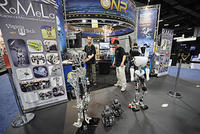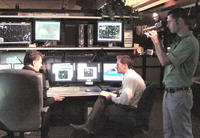-
Robot for shipboard firefighting

In both war and peace, fire in the shipboard environment is serious and frequently results in excessive damage and high repair costs because the fire is not detected or controlled adequately; researchershave developed a humanoid robot that could fight fires on the next generation of combatants
-
-
National Academies calls for expanded nuclear-fusion research
A report out on Wednesday from the National Academies says university researchers studying nuclear fusion still have a long way to go before overcoming the many scientific hurdles to the commercial generation of what is hoped to be a virtually limitless supply of energy
-
-
Shift to green energy could mean crunch in rare Earth metals supply
A large-scale shift from coal-fired electric power plants and gasoline-fueled cars to wind turbines and electric vehicles could increase demand for two already-scarce metals — available almost exclusively in China — by 600-2,600 percent over the next twenty-five years
-
-
High manganese levels making air breathing dangerous in some areas
In residential neighborhoods near manufacturing industries, a breath of air may be more hazardous than refreshing; research finds manganese concentrations higher in residential neighborhoods than industrial sites, levels vary by region
-
-
DARPA sponsors development of deep-sea surveillance robot
New Unmanned Underwater Vehicles (UUVs) to address Anti-Submarine Warfare (ASW) surveillance needs over large, operationally demanding areas
-
-
Balancing safety, risk in the debate over the new H5N1 viruses
This fall, the U.S. National Science Advisory Board for Biosecurity (NSABB) set off a debate when it asked the authors of two recent H5N1 research studies and the scientific journals that planned to publish them to withhold important details of the research in the interest of biosecurity; the scientific community is divided over the issue of best to balance free research and security
-
-
If Japan-like disaster happened in U.S., results would be far worse
An estimated 20,000 people died or are still missing after a massive earthquake-induced tsunami struck Japan on 11 March 2011, yet some 200,000 people were in the inundation zone at the time; experts say that if the same magnitude earthquake and tsunami hits the Pacific Northwest, the death toll will be much higher because of the lack of comparable preparation; that 90 percent rate could be the number of victims, not survivors
-
-
Industry: current chemical safety standards sufficient, should be extended
DHS’s management of the U.S. chemical plant safety has come under criticism lately, but he Society of Chemical Manufactures and Affiliates (SOCMA) said it strongly supports U.S. chemical security standards; the industry associated noted that since the program’s 2007 launch, more than 2,000 facilities have changed processes or inventories such that they are no longer considered high-risk under the Chemical Facility Anti-Terrorism Standards (CFATS)
-
-
Solving the major problem of renewable energy: intermittency
Intermittency, sometimes called the Achilles’ heel of renewable energy, has so far limited the penetration of renewable sources in most power grids; engineers imagine an energy future where giant transmission grids are backed up by massive energy storage units
-
-
Better to use spray rather than a gun in bear encounters
Carrying a gun in bear country does not mean you are more protected in the event of a bear encounter; researchers say people should behave cautiously and carry bear spray instead
-
-
National Weather Service budget cuts threaten poor IT infrastructure

The Obama administration has proposed cutting more than $39 million from the National Weather Service’s (NWS) budget, particularly from its IT department, and critics worry that the cuts could cause the agency’s already crippling infrastructure problems to grow worse
-
-
Company develops telephone line “fingerprint” detector
Researchers at Pindrop, a new security company, have developed technology that can read telephone line “fingerprints” to prevent fraud and identify a caller
-
-
Increase in groundwater demands due to climate change
As precipitation becomes less frequent due to climate change, lake and reservoir levels will drop and people will increasingly turn to groundwater for agricultural, industrial, and drinking water needs; the resource accounts for nearly half of all drinking water worldwide, but recharges at a much slower rate than aboveground water sources and in many cases is nonrenewable
-
-
Pasta-shaped radio waves beamed across Venice
One solution to communication congestion during emergencies is to create a public safety-dedicated band of the spectrum, allowing for a unified and uninterrupted communication among first responders; another solution is twisting radio waves into the shape of fusilli pasta, allowing a potentially infinite number of channels to be broadcast and received
-
-
Poultry feathers-based filters remove arsenic from water
Thousands of people die each year in developing countries from drinking arsenic-contaminated water; researchers develop inexpensive filters made from the modified protein (keratin) in poultry feathers to remove arsenic from drinking water
-
More headlines
The long view
New Technology is Keeping the Skies Safe
DHS S&T Baggage, Cargo, and People Screening (BCP) Program develops state-of-the-art screening solutions to help secure airspace, communities, and borders
Factories First: Winning the Drone War Before It Starts
Wars are won by factories before they are won on the battlefield,Martin C. Feldmann writes, noting that the United States lacks the manufacturing depth for the coming drone age. Rectifying this situation “will take far more than procurement tweaks,” Feldmann writes. “It demands a national-level, wartime-scale industrial mobilization.”
How Artificial General Intelligence Could Affect the Rise and Fall of Nations
Visions for potential AGI futures: A new report from RAND aims to stimulate thinking among policymakers about possible impacts of the development of artificial general intelligence (AGI) on geopolitics and the world order.
Smaller Nuclear Reactors Spark Renewed Interest in a Once-Shunned Energy Source
In the past two years, half the states have taken action to promote nuclear power, from creating nuclear task forces to integrating nuclear into long-term energy plans.
Keeping the Lights on with Nuclear Waste: Radiochemistry Transforms Nuclear Waste into Strategic Materials
How UNLV radiochemistry is pioneering the future of energy in the Southwest by salvaging strategic materials from nuclear dumps –and making it safe.
Model Predicts Long-Term Effects of Nuclear Waste on Underground Disposal Systems
The simulations matched results from an underground lab experiment in Switzerland, suggesting modeling could be used to validate the safety of nuclear disposal sites.
